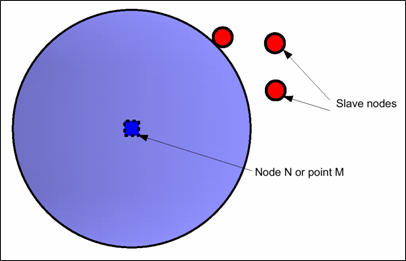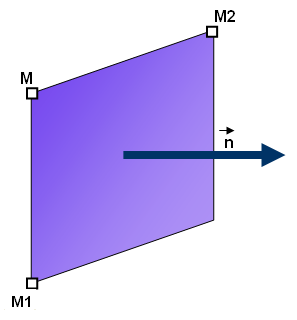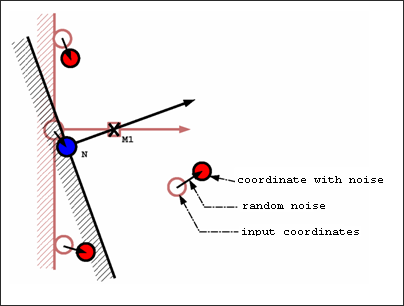Rigid Wall (/RWALL)
A rigid wall is a nodal constraint applied to a set of secondary nodes in order to avoid the node penetration to the wall. If contact is detected, then the secondary node acceleration and velocity are modified.
There is no gap to determine whether or not a secondary node is in contact. Contact occurs only when the secondary node impacts the rigid wall surface. The secondary node's tangential velocity can also be modified depending on the flag Slide. The default value (=0) enables the model pure sliding during contact. If set to 1, no sliding is allowed, the secondary nodes are "tied" in the tangential direction. If set to 2, friction based on Coulomb model is enabled.
The rigid walls can be fixed or moving. A fixed wall is a pure kinematic condition on all impacted nodes; whereas a moving wall is similar to a main secondary option. A main node defines the wall position at each time step and imposes velocity on impacted secondary nodes. Impacted secondary node forces are applied to main node. The secondary node forces are computed with momentum conservation. The mass of a secondary node is not transmitted to a main node, assuming a large rigid wall mass compared to impacted secondary nodes mass.
Infinite Rigid Wall

Figure 1. Infinite Rigid Wall
Infinite Cylindrical Wall

Figure 2. Infinite Cylindrical Wall
Spherical Wall

Figure 3. Spherical Wall
Finite Planar Wall

Figure 4. Finite Planar Rigid Wall
Comments
- During the simulation of a moving wall is following the main node N but the wall orientation remains constant and parallel to initial normal. A moving rigid wall does not respect the moment equilibrium, only force equilibrium is applied. An external moment is; therefore, applied from laboratory to the wall.
- If the secondary nodes are defined with a distance from the wall only, the nodes with positive or zero distance are considered (that is the nodes behind the infinite wall or in the cylinder wall are not considered as secondary).
- A node initially impacted into a wall cannot rebound; except if the rebound velocity is high enough to go out from the wall in only one cycle.
- If a random noise is added to the node coordinates, the initial position of secondary nodes are modified and for a moving wall, the wall location is changed. Therefore, it is possible that some secondary nodes with zero or near zero distance from the wall move inside the wall. If secondary nodes are defined with a distance, these nodes are not secondary nodes. If these nodes are explicit secondary nodes, they will stay inside the wall without possible rebound.
- With random noise
(/RANDOM) the orientation of a moving wall is also
affected. Location of main node N is moved with random value and the normal defined with
node N and point M1 is changed. This is especially critical if
point M1 is close to point N.

Figure 5. Change in Wall Orientation, Due to Random Noise